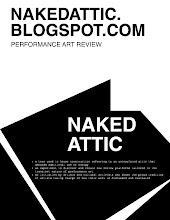Twelve days into Performa 09 and nothing much stands out to write about. However, I have seen some great local, experimental, less-expensive performances in the same twelve days. It is possible that my attraction to one over the other is structural. All the Performa events seem very safe and produced for easy consumption.
Firstly, in celebration of the 100-year anniversary of Filippo Tommaso Marinetti’s ‘Manifesto of Futurism,’ Performa has integrated the theme of futurism into its programming. The first publication of this text in 1909 (Boccioni’s application of the manifesto to the visual arts came in 1910) is highly problematic in a contemporary space. It is about recklessness without accountability to a community or society, and blatantly misogynistic. There are only eleven points in the document; and Points 9 and 10 state: “We will glorify war – the world’s only hygiene – militarism, patriotism, the destructive gesture of freedom-bringers, beautiful ideas worth dying for, and scorn for women.” and “We will destroy the museums, libraries, academies of every kind, we will fight moralism, feminism, every opportunistic or utilitarian cowardice.” The 1909 manifesto stands revered and celebrated by Performa by renewing its content to a contemporary place without a critical or problematized platform.
Next, Performa is self-defined as a biennial dedicated to performance. However, the Performa Commissions program originates new performances by inviting artists, “many of whom have not worked ‘live’ before” to create work especially for the Performa biennial. This is a decision to promote already-deemed-acceptable artists to be shown yet again, versus taking risks and allowing un-tested emerging artists a larger platform that they rarely have access to. Also, the hand-selected commissioned artists work closely with the Performa production team from conceptualization to presentation. This, I suspect, is my reason for thinking that everything feels safe or tamed, like it has been tested for an uncritical (and paying) audience.
On the other hand, I went to the (non-Performa event) AUNTS Roadshow where I encountered a refreshing destabilizing experience as a viewer. The performances were non-hierarchical and happening everywhere in the space at once. Admission is a barter system, or a contribution to the free boutique/free bar, where everyone shops and drinks for free. It was a chain curation where the performers could do as many performances as they wanted, as long as they negotiated it with other performers in that evening. And, plenty of the works trusted my thinking ability as an spectator and I am still chewing on some in my head.
Granted, I haven’t yet seen many Performa events, I did see some of the Futurist Film programming at the Anthology film Archive and the works were lovely and easy to watch. They confirmed a traditional societal structure and did not make me have many questions as a spectator. Admission: $9
The Tacita Dean piece did not feel challenging either. The feature length film of Merce Cunningham’s dancers rehearsing in a gorgeous warehouse was a profoundly beautiful quotation to the end of his life, but not much else. I am always skeptical of beautiful film subjects (dancers, the warehouse, the Bay and sunlight) fueling a narrative. Watching in-shape bodies perform entertaining gestures is endlessly beautiful. The lack of musical soundtrack was the strongest aspect of the work. The juxtaposition of images of Merce Cunningham with the sounds of dancing feet was moving. Admission $10
Another performance I went to within the last twelve days was Will Rawls’ “Planet Eaters” at the Dance Theatre Workshop. This was not a Performa event, but an exciting model of risk and community. The event was part of the Studio Series; and Rawls used the evening to get feedback from the audience of about 40 people. He shared four movement sequences with us and asked us questions in between. At the end, we all sat in a circle and talked through some of our answers and thought. It was engaging critical dialogue and I appreciated the work that was being asked of me as spectator. Donation: $3
The Performa biennial claims to “build an exciting community of artists and audiences” however, a trusting, critical performance arts community already exists! Talented, questioning, hard-working performance artists are vibrant in this city and challenging the structures of how performance is shared. Performa feels regressive to me because it is pre-ordained and a modern construct for art tourism, based solely on art as entertainment. I was in conflict about writing a blog about Performa, because I did not want to contribute to the bloated attention that the festival is already receiving. Despite my hesitations and disappointments, I will continue to seek and share my observations for the last ten days.
-- Lindsay L Benedict
.jpg)
1 comment:
I couldn’t disagree more! While there are undoubtedly issues afoot with the Performa biennial (and it would be useful to have a conversation here about that) the criticisms that you raise seem - and please forgive my being blunt, a bit flat. Yes, produced events have admissions (the vast majority of the 60? 70? on the program do not), yes, Futurism was loosely used as a curatorial device – you would be hard pressed to name a centennial performative movement that was not misogynistic, let alone so deeply formative. I think that the curatorial conceit (that you criticize) of having artists who don’t usually use performance generate one is a succinct and charged idea. They don’t do it at the exclusion of artists that are engaged with performance (or for that matter, emerging artists – have you seen the program?!)– it is in addition to those artists and serves the worthwhile effort of energizing a field of new possibilities.
Your critical language revolves around terms that suggest that Performa has failed to live up to the mandate of (capital P) performance art – ‘art as entertainment’ ‘regressive’ ‘very safe and produced for easy consumption’ – although (as you point out yourself) you’ve only been to see two films. Have you seen any live work yet?
Post a Comment